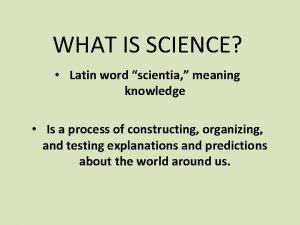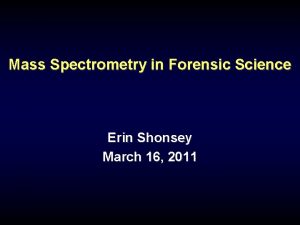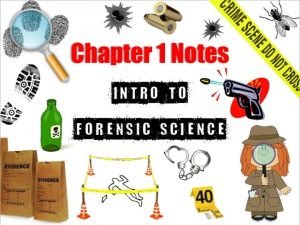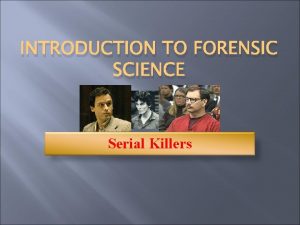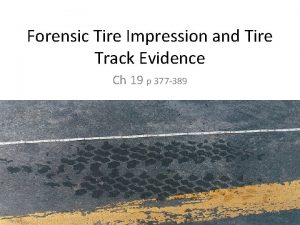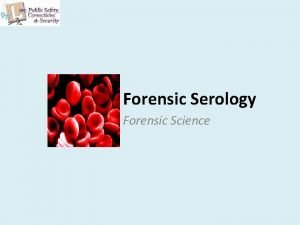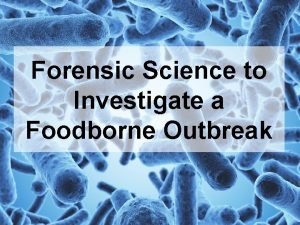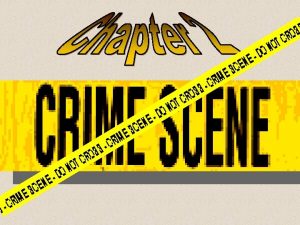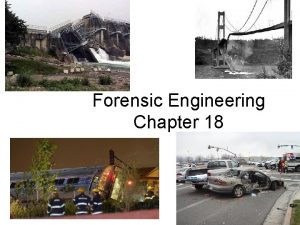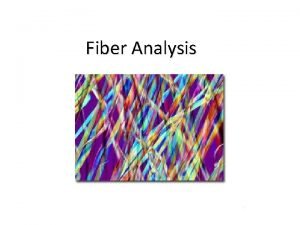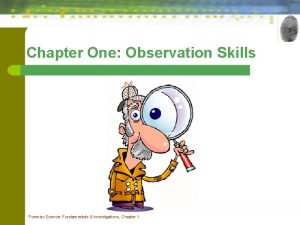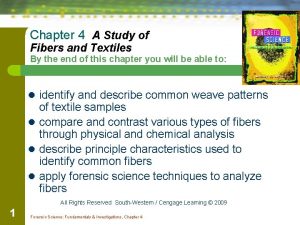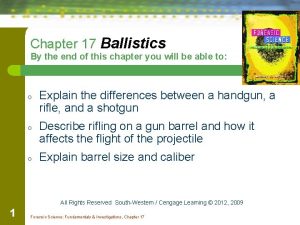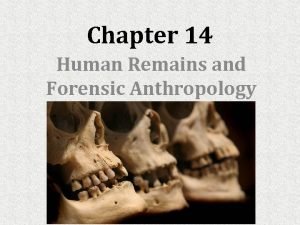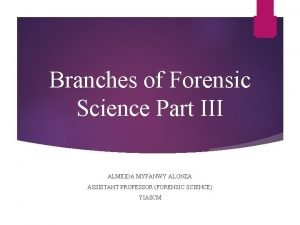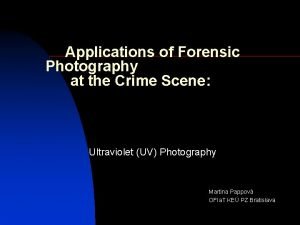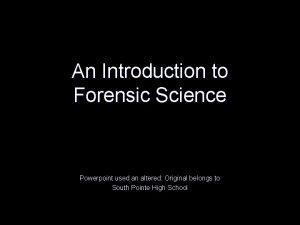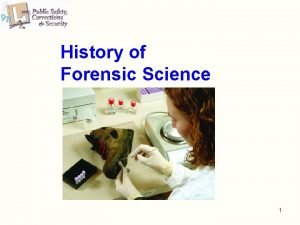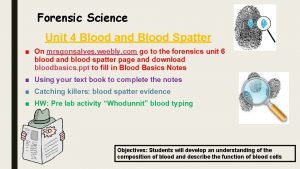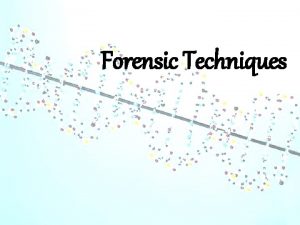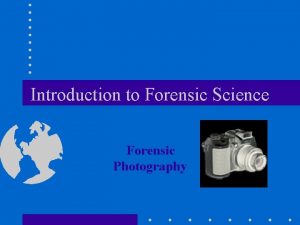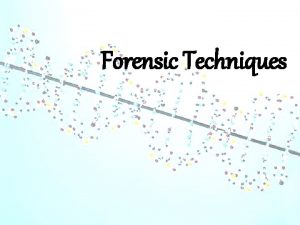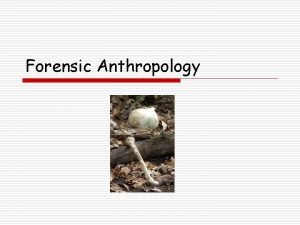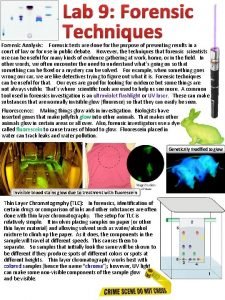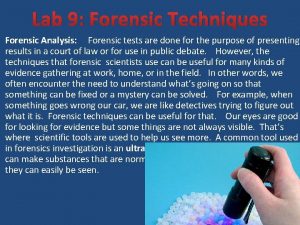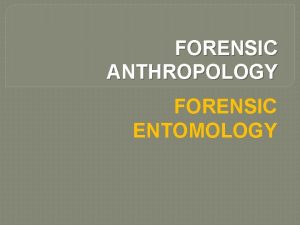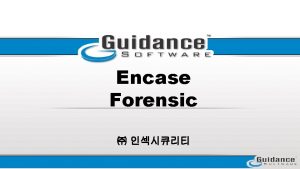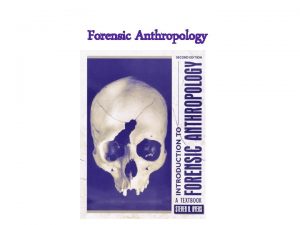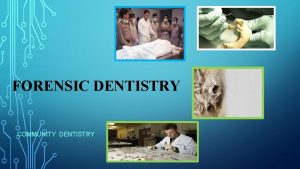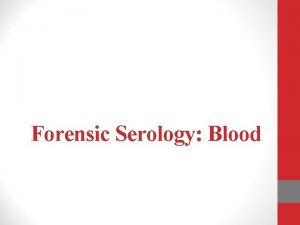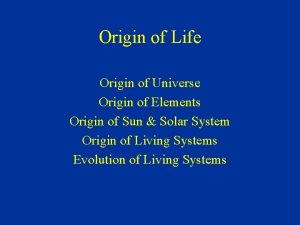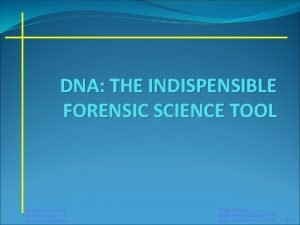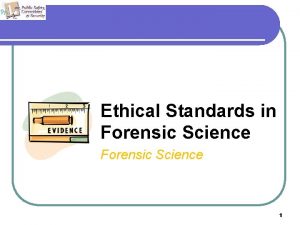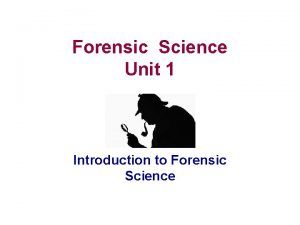What is Forensic Science Origin of the Word































- Slides: 31

What is Forensic Science?

Origin of the Word Forensics derived from the Latin word forensis, meaning forum, a public place used in Roman times by senators to debate and hold judicial proceedings

What is forensic science? The study and application of science to matters of law Examines the associations between people, places, things and events involved in crimes AKA criminalistics The examination of physical evidence ▪ Evidence: anything that tends to establish OR disprove a fact Includes: ▪ Testimony ▪ Objects ▪ documents

Forensic Science Forensic science is the application of natural sciences to matters of the law. In practice, forensic science draws upon physics, chemistry, biology, and other scientific principles and methods. It is concerned with the recognition, identification, individualization, and evaluation of physical evidence. Forensic scientists present their findings as expert witnesses in the court of law.

Truth vs. Myth What do you think is realistic or unrealistic about the forensic science that is represented in the media?

What is the C. S. I. Effect? A recent phenomenon, creating elevated standards and heightened expectations in the minds of jurors and others of the ability of real-life forensic science, that arose from television shows like CSI, which can distort the reality of the science.

The C. S. I. Effect Crime labs are well equipped with the latest high-tech instrumentation Crime scene investigators process the crime scene. Crime scene investigators know and do everything. Crimes can be solved within the hour with hightech equipment DNA can solve most crimes All cases can be solved with high-tech science Forensic science results are never wrong Fingerprints can be checked immediately with a large computer database Forensic science is glamorous CSI cannot immediately begin investigating crime scene

Crime Scene Team A group of professionals investigators, each trained in a variety of special disciplines. Team Members ã ã ã First Police Officer on the scene Medics (if necessary) Investigator(s) Medical Examiner (if necessary) Photographer and/or Field Evidence Technician Lab Experts pathologist DNA expert forensic odontologist forensic psychologist firearm examiner document and handwriting experts serologist toxicologist forensic anthropologist forensic entomologist bomb and arson expert fingerprint expert 8

The Locard Principle 1. You are sitting at your desk. What are you in contact with? What possible transfer of material could have taken place? Make a list. How could you have prevented any transfer if you had thought about it first? What transferred material could be traced back to you directly and what units of a crime lab would be used to trace it back to you? 2. Think about when you came to school today. Did you leave any evidence that you were here other than being observed by others (eye witnesses)? 3. Is it difficult not to leave a trace? And, after the fact, is there lots to worry about from leaving evidence of your presence? 4. Do you think premeditated contact can diminish identifiable transfers? Give some examples of where destroying evidence could leave more that could identify you.

Forensic Scientist Job description Study evidence found at the crime ▪ ID object, its origin, and how it got to the crime scene Expert witness ▪ At trial, present data, weighs evidence, gives impartial opinion in court Researcher ▪ Performs scientific research and trains other scientists

The History of Forensic Science Sherlock Holmes: a fictional character developed by Sir Arthur Conan Doyle; used a great deal of forensic detection Mathieu Orfila: toxicology (the detection of poisons) Alphonse Bertillon: anthropometry (personal identification through body measurements) Francis Galton: developed 1 st fingerprint identification system Leone Lattes: determined methods of using blood type as a means of identification Calvin Goddard: firearms examination Albert Osborn: document examination Edmund Locard: Developed the 1 st police lab J. Edgar Hoover: director of the FBI: Organized the 1 st FBI Crime Lab in 1932 11

Edmond Locard History Early 1900’s Forensic investigator Believed criminal should be connected to the crime by trace evidence collected at the crime scene • “Whenever 2 objects come into contact, there is a transfer of material. The methods of detection may not be sensitive enough to demonstrate this or the decay rate may be too rapid that all evidence or transfer has vanished after a given amount of time. None the less, the transfer has taken place. ”

Steps in Investigation Crime Scene Investigators arrive on the scene and make sure it is secure. They secure large areas they believe to be part of the crime scene. This CSI will not just start collecting evidence, CSI needs search warrants. Any evidence collected without a warrant will not have value in court.

Basic Crime Scene Run Through They will complete an initial walk through and get a feel for the crime scene They will make some initial theories and make notes of potential evidence. CSI will document scene by taking photographs and drawing sketches during second walk through. Nothing is touched.

Crime Scene Search Patterns TWO of FOUR PATTERNS FSpiral F Grid 15

Crime Scene Search Patterns TWO of FOUR PATTERNS FStrip or Line F Quadrant or Zone 16

After these steps have been completed, evidence can now be collected, tagged, logged, and packaged so it may be sent to be analyzed. Evidence is analyzed in a crime labs.

Difference Types of Evidence Physical Behavioral Testimonial Documentary

PHYSICAL EVIDENCE Physical evidence is any tangible article, small or large, which tends to prove or disprove a point in question. It may be used to: 1. Reconstruct the crime 2. Identify the participants 3. Confirm or discredit an alibi

Types of Physical Evidence Transient Evidence Pattern Evidence Conditional Transfer Evidence Associative Evidenc

Types of Evidence Class evidence physical evidence that belongs to a group of people or objects - Identifying fabric as denim, or identifying a substance is blood, tire tracks Individual evidence physical evidence that can be linked to a specific person - DNA test, fingerprints, distinct hand writing, voice analysis.

Physical Evidence Transient Evidence--temporary; ã ã easily changed or lost; usually observed by the first officer at the scene Odor--putrefaction, perfume, gasoline, urine, burning, explosives, cigarette or cigar smoke Temperature--of room, car hood, coffee, water in a bathtub; cadaver Imprints and indentations-footprints; teeth marks in perishable foods; tire marks on certain surfaces Markings 22

Physical Evidence Pattern and Impression: includes any markings produced when one object comes into contact with another object. It also includes pattern analysis, such as is used when evaluating handwriting, typewriting, and writing instruments. Bloodstains Firearms and Toolmarks Latent Prints/Tenprints Ondontology (Bitemarks) Questioned Documents Shoeprints and Tire Treads 23

Physical Evidence Transfer Evidence- Generally produced by physical contact of persons, objects, or between persons or objects Ex. Blood, semen, hair, clothing fibers

Conditional Evidence--produced by a specific event or action; a type of physical evidence that usually describes the scene and condition of the scene. â Light--headlight; lighting conditions â Smoke--color, direction of travel, density, odor â Fire--color and direction of the flames, speed of spread, temperature and condition of fire 25

Conditional Evidence (cont. ) â Location--of injuries or wounds; of bloodstains; of the victims vehicle; of weapons or cartridge cases; of broken glass, etc. â Vehicles--doors locked or unlocked, windows opened or closed; radio off or on (station); odometer mileage â Body--position; types of wounds â Scene--condition of furniture, doors and windows; any disturbance or signs of a struggle. 26

Physical Evidence Associative Evidence —items that may associate a victim or suspect with a scene or each other; ie, personal belongings

Nature of Evidence: Biological â Blood â Semen â Saliva â Sweat/Tears â Hair â Bone â Tissues â Urine â Feces â Animal Material â Insects â Bacterial/Fungal 28

Nature of Evidence: Chemical â Fibers â Glass â Soil â Gunpowder â Metal â Mineral â Narcotics â Drugs â Paper â Ink â Cosmetics â Paint â Plastic â Lubricants â Fertilizer 29

Nature of Evidence: Miscellaneous â Voice analysis â Polygraph â Photography â Stress evaluation â Pyscholinguistic analysis â Vehicle identification 30

Once Evidence is Collected Many different specialist analyze evidence and forward the information to the lead investigator. What kind of analysis can we do? ?
 Forensic anthropologist vs forensic pathologist
Forensic anthropologist vs forensic pathologist Who is this
Who is this Science science science
Science science science Latin word scientia, meaning 'knowledge'.
Latin word scientia, meaning 'knowledge'. Hegar sign in pregnancy
Hegar sign in pregnancy Morphology of hair forensic science
Morphology of hair forensic science Mass spectrometry in forensic science
Mass spectrometry in forensic science Who established the first workable crime laboratory?
Who established the first workable crime laboratory? Richard ramirez ac dc hat for sale
Richard ramirez ac dc hat for sale Father of forensic toxicology
Father of forensic toxicology Tire impressions
Tire impressions Cins ve tür arasındaki farkı örneklerle açıklayınız
Cins ve tür arasındaki farkı örneklerle açıklayınız Unit 1 introduction to forensic science
Unit 1 introduction to forensic science Forensic science foodborne outbreak investigation answers
Forensic science foodborne outbreak investigation answers Definition of forensic science
Definition of forensic science Forensic science begins at the crime scene.
Forensic science begins at the crime scene. Forensic science arson activity
Forensic science arson activity Forensic science chapter 18 review answers
Forensic science chapter 18 review answers Hair and fiber evidence worksheet answers
Hair and fiber evidence worksheet answers What a person perceives using senses
What a person perceives using senses Weave patterns of fibers forensics
Weave patterns of fibers forensics Unscented trajectory chapter 17
Unscented trajectory chapter 17 Chapter 14 forensic anthropology
Chapter 14 forensic anthropology Forensic science branches
Forensic science branches Uv photography in forensic science
Uv photography in forensic science Forensic science ppt
Forensic science ppt Final sketch
Final sketch Department of forensic science dc
Department of forensic science dc Paul kirk forensic science
Paul kirk forensic science Valentin ross forensics
Valentin ross forensics Forensic science blood basics notes
Forensic science blood basics notes Forensic scientist jobs
Forensic scientist jobs



